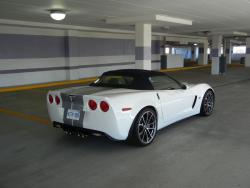 2013 Chevrolet Corvette 427 Convertible. Click image to enlarge |
|
Quick Spin: 2012 Audi R8 GT Spyder
Manufacturer’s website |
Review and photos by Jonathan Yarkony
Photo Gallery:
2013 Chevrolet Corvette
I’m not going to bore you with a history lesson. Yes, this car commemorates 60 years of Corvettes, but it is awesome right now, so I feel the urge to tell you all about its current awesomeness rather than regale you with stories of its past glory, of which there is also no shortage of material.
And this 427 Convertible Collector Edition is a great way to send off the C6 Corvette, the Corvette platform that has been in production since 2004, and carried the torch passed on by the C5R’s return to racing dominance in the ALMS GT classes and Le Mans.
A standard Corvette or Corvette convertible is no slouch, powered by a 6.2L V8 making 430 hp, but the 427 borrows the 7.0L “LS7” V8 from the formerly kingpin Z06 Coupe (though not the Z06’s aluminum frame, rather the base Corvette convertible’s steel frame), the 427 name a nod to the displacement in cubic inches (427.65, to be exact). As everyone should know by now, the new ‘Alpha’ Vette is the ZR1, featuring the almighty “LS9”, a supercharged 6.2L V8 making 638 hp and 604 lb-ft—I cannot comprehend what that kind of power and acceleration would be like. I can barely comprehend what it was like piloting this thing to its full potential.
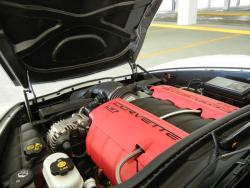 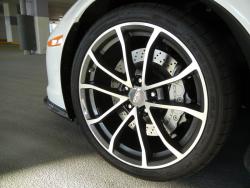 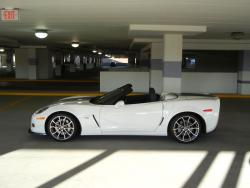 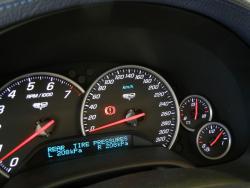 2013 Chevrolet Corvette 427 Convertible. Click image to enlarge |
But back to the 427, whose LS7 makes a still staggering 505 hp, 470 lb-ft of torque, and sounds like a chainsaw-wielding tyrannosaurus of the apocalypse is chasing you down when you induce ‘loud’ mode by breaking into the high revs at wide-open throttle—reason enough to try to drive even faster, right?
And faster it goes, weighing only 1,522 kg (3,355 lb.), it hits 60 mph (97 km/h) in 3.8 seconds, runs a quarter-mile in 11.8 seconds, can achieve a maximum lateral acceleration of 1.04 g and a top speed of more than 304 km/h (190 mph). If only our world was a racetrack, I’d have verification of all those numbers, but instead you’ll just have to trust me: it’s fast! And did I mention it sounds great?
In every respect, it feels the sports car, and even a barely disguised racecar. There are plenty of purpose-built racecars that would be hard pressed to keep up with it even if it wasn’t boasting those 505 hp. The tires are, in fact, track-ready tools: Michelin Pilot Sports measuring 285/30ZR19 on 19×10-inch wheels in front and 335/25ZR20 on 20×12-inch wheels in the back, the design a machine-face cup style lightweight aluminum. Yes, you read that correctly, the rear tires are a foot wide. Even with that wide a contact patch, and some of the stickiest road-legal rubber, they have no hope against that kind of power fed through a heavy duty six-speed manual transmission to the rear wheels only.
I was strictly warned against burnouts (and loose women, for some reason), but there is no way to drive that car without, ahem, breaking traction under certain conditions. Like accelerating out of a corner, or a standing start when a light turns green, or doing anything on a cold, fall morning. One thing I found handy during our rather chilly week was the tire pressure monitor in the gauge cluster info screen, which gave me a good indication that the tires were nicely warmed up when they reached 212–216 kPa.
With safety in mind, I kept all safety systems on all the time (okay, most of all the time…), but even so, the Corvette would step out and play when handled, um, how shall we say, indelicately. Turn-in is quick, and when the weather was warmer and dry, the grip was heroic, but those huge, wide tires loved to chase every rut, crown, or pavement heave in the road, so a firm grip on the wheel is called for to keep the 427 reined in (wait, am I allowed to use horse analogies in Corvette stories?). You might think that’s disconcerting, but I found it fun, though I’m not sure if I’d find it fun if I drove it regularly.














